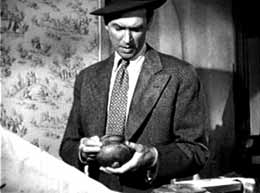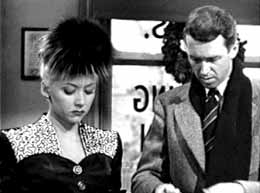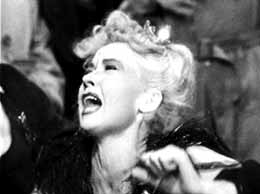
 |
Georg Bailey (James Stewart) in "It's a Wonderful Life" by Frank Capra |
"It's a Wonderful Life" remains one of America's favorite idealizations of itself. It's become something like the gift that keeps on giving – opened and reopened each Christmas, year after year, with one collective, nostalgic sigh. Like Dickens's Christmas stories, the movie became a holiday classic by virtue of its sentimentality rather than despite it. At the heart of the package of "It's a Wonderful Life" is George Bailey, an everyman, decent small town guy with an adventurer's spirit and a hefty load of family and community responsibilities. George's problem is that he doesn't enjoy the success of so many men around him because he is always stuck at home – he's really another kind of man, the movie implies, a kind of homemaker in many respects, who is finally made to unravel. While the pressure of being George nearly kills him, in the end his confining responsibilities are redeemed as positive values – generosity and simple trust prevail over profit, self-sacrifice becomes as honored as personal ambition and friends are as good as gold. George's masculinity is not threatened by the fact that he is never "his own man", that his choices in life are made in deference to the needs of his family and friends. On the contrary, George's "compromised" masculinity is responsible for making the world a better place. George moves in a sphere of sympathetic relations where women are usually most at home. The virtues of George's masculinity contrast sharply with the actor Jimmy Stewart's real life experiences in World War II. Stewart was a bomber pilot with more than 2000 hours in the air – a real life American hero. Capra himself worked for the U.S. Army Special Services and produced a series of short propaganda films entitled "Why We Fight". "It's a Wonderful Life" contains substantial documentary footage from the war. Capra uses these pieces to flesh out the lives of the other characters in the film who, unlike George with his bum ear, were able to fight in the war. The footage includes dramatic shots of hundreds of airplanes with parachutes dropping from them into France and the taking of Remagen Bridge. For the viewer they brought back to the homefront harrowing scenes that
 |
Violet Bicks Gloria Grahame and Georg Bailey (James Stewart) |
Americans were already trying to forget. The slippage between the actual footage from World War II of what was then a very fresh and as yet unexamined historical view and the sentimental fictional narrative echos Capra's structure for the narrative which is divided into two distinct worlds. First of all there is the world in which George Bailey takes part and secondly the world in which George Bailey has never been born. It is not that strange that viewing the film "It's a Wonderful Life" from the vantage point of 54 years after its release it can confuse the viewer concerning exactly what American values are being addressed and where to position oneself in relation to the film's ideology. More confusing still is how the contemporary viewer is supposed to process all of the historical details Capra packs into his film concerning World War II. While the values in the film are like a "door that swings both ways" – capable of being embraced by both the left and the right – the film appears to shift to the left with each passing year. The structure of Capra's film hinges on the theme of contingency, that of one thing following another – a theme that Stephen Jay Gould the natural historian discusses in the preface to his book about the reinterpretation of the Burgess Fossils, entitled Wonderful Life. Gould states that: "This theme (contingency) is central to the most memorable scene in America's most beloved film – Jimmy Stewart's guardian angel replaying life's tape without him, and demonstrating the awesome power of apparent insignificance in history." In Gould's book a forceful argument is made for the power of the tiniest details – when the smallest detail is overlooked or misinterpreted entire theories of natural history must be amended. Gould's homage to Capra and Stewart describes the reason for the film's popularity and the fascination we have in watching it again and again without being bored. The viewer can always enter the narrative as one of Capra's everyman or everywoman.
 |
Violet Bicks (Gloria Grahame) getting arrested in George Baileys dream |
The
viewer can also always wonder what might have happened if different
circumstances prevailed. With Gould's statement in tow there are two
characters which prompt me to move outside of the film in consideration
of it. They have always held the most interest for me because they
uncomfortably draw attention to both Capra's obvious deficiencies
as well as his obvious strengths. Violet Bick: The first character
to consider is the minor character Violet Bick. Because of her restless
ambition (which acts as a mirror throughout for George) Violet Bick
the film's "good" bad girl seemed to me to be the best candidate in
the film to offer the possibility of some type of feminist/historical
intervention. While Capra fashions an appealing and somewhat radical
leading man, the representation of women in the movie is less liberal.
Capra exhausts the most glaring of feminine stereotypes, the barren
spinster, the whore and the angelic wife. The period of the film moves
through World War II and was a time of change for many women. Women
took over men's jobs on the homefront as they went off to war, they
became the heads of households and many attained financial independence
for the first time. This trend was reversed as soldiers returned home
after the war and the country moved into one of its most sexually
conservative periods. Capra ignores this reality in his version of
the war and post-war years. In 1947 Capra was in Oscar competition
with his friend and partner in Liberty Films, William Wyler director
of "The Best Years of Our Lives" which dealt with the plight of returning
World War II soldiers and matched the mood of post-war America; "It's
a Wonderful Life" lost and Wyler took home the Oscar for Best Picture
of 1946. All of the events in Violet's film life remain unanswered
questions. Why does she want to move to New York City? Why is she
arrested in the film segment where George has never been born? The
arrest scene is extremely violent and chaotic for what purports to
be a holiday film. Violet is wrenched to and from in front of the
camera. In contrast to her female counterparts in the film she doesn't
shrink away to become a librarian or the keeper of a seedy boarding
house, she is pictured out on the street fighting her oppressors.
It is implied that she is arrested because she is a streetwalker but
this is never explicitly stated. I prefer to assume that Violet is
a sex radical, not a streetwalker, a rambunctious femme caught up
in a bar raid. Afterall, Capra took great pains in detailing the bar
scenes in this film and the references to gay sexuality are present
if we look for them. There is a hilarious scene with George and Clarence
at a bar with a populist atmosphere including a black jazz pianist
and single women drinking together at the bar. Clarence's effeminate
mannerisms compounded by his request for mulled wine and his yammering
about angels and wings prove too much for the working-class bartender
who calls them "pixies" and has them thrown out into the wintry street.
"Pixies" was a clear reference to homo- sexuals and yet in this case
the underlying message counters the bartender's apparent homophobia
since Clarence and George remain the oppressed heros of the story.
In a city so enveloped by vice as evidenced by all the neon signs
advertising "live girls" etc. would the police be so invested in arresting
Violet merely for prositiution? I've often felt that Violet's brutal
arrest was prompted by a more transgressive event.  Then
there is Violet the adventurer. She like George, is in a hurry to
leave Bedford Falls for New York City. Like the women in the seedy
bar where Clarence and George find themselves Violet is most likely
a working class girl. There is no evidence that Violet went to college
like George, Mary, Sam and Harry. Despite this she has enough self-confidence
to try to make it in New York City. But, like George, Violet puts
off her departure in order to come to George's aid by giving back
the money she borrowed for her move – this film emphasizes once more
that friendship is worth far more than ambition and success. Bedford
Falls/Seneca Falls: Because Capra so lovingly attended to the articulation
of the town of Bedford Falls there is enough detail in his fictional
portrayal that it is possible to make comparisons to real American
cities. A few cities have claimed to be the model for Capra's Bedford
Falls but in 1996 a journalist brought Seneca Falls to the forefront
of this list. Seneca Falls is a village of about 8,000 inhabitants
at the lower apex of a triangle formed with Syracuse about forty miles
to the northeast and Rochester about fifty miles to the northwest.
So convincing were the comparisons that Seneca Falls now celebrates
Christmas by enacting scenes from the film. The town has also installed
street signs that pertain to the film (Angel Street, George Bailey
Blvd., Bedford Falls Blvd. and Clarence Street). Some of the comparisons
between Bedford Falls and Seneca Falls are: 1) The Bridge Street Bridge
looks very similar to the bridge George Bailey jumps from in the movie.
2) In April 1917 there was an incident of a man jumping off the Bridge
Street Bridge to save a young woman. He died after saving the woman.
There is now a plaque on the bridge to commemorate this incident.
3) Part of downtown Seneca Falls at one time had a grassy median dividing
the main street, much like Bedford Falls in the film. 4) There are
many Victorian era houses in Seneca Falls and there is one across
the street from the Historical Society that resembles the home George
and Mary move into on their wedding night in the film. 5) In the movie,
the Bailey Savings and Loan Association builds low-cost homes†in an
area known as Bailey Park. In the 19th century, factory owner John
Rumsey helped immigrant workers in Seneca Falls by lending money and
building low-cost housing in the neighborhood still known as Rumseyville.
6) In the movie there are references to nearby cities in Western New
York such as Elmira and Buffalo. Seneca Falls is situated in the part
of New York State that was known in the nineteenth century known as
the reform belt and active in many reform movements including, Women's
Rights, Indian Rights, Abolition and labor reform. Seneca Falls' most
significant history does not make its way into Capra's town Bedford
Falls. Seneca Falls is best known as the birthplace of Women's Rights
in America. It is in Seneca Falls where, in 1848, Elizabeth Cady Stanton
organized the first Women's Rights Convention in America. Among those
who attended was Frederick Douglass. Douglass was the only man in
attendance who spoke in favor of a women's right to vote. It is also
in Seneca Falls where Stanton met Susan B. Anthony and formed a lifelong
bond to work towards securing the right to vote for women. Charlotte
Woodward, a worker from the Seneca Falls Knitting Mill, attended the
conference in 1848 and was the only woman in attendance who lived
to cast a vote in 1920 following the passage of the 19th amendment
to the Constitution. But Seneca Falls, like many of the small towns
and cities in upstate New York that were thriving industrial and urban
meccas in the nineteenth century through the 1940's, thereafter began
a slow and steady decline. Now the main street of Seneca Falls can
appear abandoned with many empty storefronts while just outside of
the city there is a thriving "outlet center". What is at stake for
a town like Seneca Falls in locating itself in the film "It's a Wonderful
Life" is finding in itself an idealized America, an America that no
longer exists and most probably never really existed at all. What
happened to all of these cities in Upstate New York, where huge department
stores, civic centers and even entire blocks are empty with "for rent"
signs all over is also one of the reasons why Capra's film is so well
loved. He captures in some part, the life of these cities before their
death. At the same time he foreshadows the problems faced by these
cities and towns. In his film there is aready a sense of lost innocence
impinging on the film at all points in the narrative. There is a threat
to the ethics of community and friendship which are opposed to economic
progress. Capra's Bedford Falls is a fantasy because it must represent
at the same time opposite and conflicting American virtues. The title
"The Moral Museum" is from the memoirs of Elizabeth Cady Stanton.
She used it to refer to a dinner party she attended in Boston where
most of the reformers of the period representing different causes
happened to be assembled at the same table. In considering the real
town of Seneca Falls and its civic pride in both its assumed relationship
to the film "It's a Wonderful Life" and its position in history as
"the birthplace of Women's Rights", the title is meant to refer to
the values set forth in the film as well as those values explored
by the actual reformers of the nineteenth century in Seneca Falls.
By embracing both of these disparate influences as part of its inheritance
the town of Seneca Falls is in part defined by both. By linking the
film's values to the reformers of the nineteenth century connected
with Seneca Falls, and some of the political events of the 1940's
to a long line of political activism and reform not addressed by the
film causes the film's values to swing farther to the left.
Then
there is Violet the adventurer. She like George, is in a hurry to
leave Bedford Falls for New York City. Like the women in the seedy
bar where Clarence and George find themselves Violet is most likely
a working class girl. There is no evidence that Violet went to college
like George, Mary, Sam and Harry. Despite this she has enough self-confidence
to try to make it in New York City. But, like George, Violet puts
off her departure in order to come to George's aid by giving back
the money she borrowed for her move – this film emphasizes once more
that friendship is worth far more than ambition and success. Bedford
Falls/Seneca Falls: Because Capra so lovingly attended to the articulation
of the town of Bedford Falls there is enough detail in his fictional
portrayal that it is possible to make comparisons to real American
cities. A few cities have claimed to be the model for Capra's Bedford
Falls but in 1996 a journalist brought Seneca Falls to the forefront
of this list. Seneca Falls is a village of about 8,000 inhabitants
at the lower apex of a triangle formed with Syracuse about forty miles
to the northeast and Rochester about fifty miles to the northwest.
So convincing were the comparisons that Seneca Falls now celebrates
Christmas by enacting scenes from the film. The town has also installed
street signs that pertain to the film (Angel Street, George Bailey
Blvd., Bedford Falls Blvd. and Clarence Street). Some of the comparisons
between Bedford Falls and Seneca Falls are: 1) The Bridge Street Bridge
looks very similar to the bridge George Bailey jumps from in the movie.
2) In April 1917 there was an incident of a man jumping off the Bridge
Street Bridge to save a young woman. He died after saving the woman.
There is now a plaque on the bridge to commemorate this incident.
3) Part of downtown Seneca Falls at one time had a grassy median dividing
the main street, much like Bedford Falls in the film. 4) There are
many Victorian era houses in Seneca Falls and there is one across
the street from the Historical Society that resembles the home George
and Mary move into on their wedding night in the film. 5) In the movie,
the Bailey Savings and Loan Association builds low-cost homes†in an
area known as Bailey Park. In the 19th century, factory owner John
Rumsey helped immigrant workers in Seneca Falls by lending money and
building low-cost housing in the neighborhood still known as Rumseyville.
6) In the movie there are references to nearby cities in Western New
York such as Elmira and Buffalo. Seneca Falls is situated in the part
of New York State that was known in the nineteenth century known as
the reform belt and active in many reform movements including, Women's
Rights, Indian Rights, Abolition and labor reform. Seneca Falls' most
significant history does not make its way into Capra's town Bedford
Falls. Seneca Falls is best known as the birthplace of Women's Rights
in America. It is in Seneca Falls where, in 1848, Elizabeth Cady Stanton
organized the first Women's Rights Convention in America. Among those
who attended was Frederick Douglass. Douglass was the only man in
attendance who spoke in favor of a women's right to vote. It is also
in Seneca Falls where Stanton met Susan B. Anthony and formed a lifelong
bond to work towards securing the right to vote for women. Charlotte
Woodward, a worker from the Seneca Falls Knitting Mill, attended the
conference in 1848 and was the only woman in attendance who lived
to cast a vote in 1920 following the passage of the 19th amendment
to the Constitution. But Seneca Falls, like many of the small towns
and cities in upstate New York that were thriving industrial and urban
meccas in the nineteenth century through the 1940's, thereafter began
a slow and steady decline. Now the main street of Seneca Falls can
appear abandoned with many empty storefronts while just outside of
the city there is a thriving "outlet center". What is at stake for
a town like Seneca Falls in locating itself in the film "It's a Wonderful
Life" is finding in itself an idealized America, an America that no
longer exists and most probably never really existed at all. What
happened to all of these cities in Upstate New York, where huge department
stores, civic centers and even entire blocks are empty with "for rent"
signs all over is also one of the reasons why Capra's film is so well
loved. He captures in some part, the life of these cities before their
death. At the same time he foreshadows the problems faced by these
cities and towns. In his film there is aready a sense of lost innocence
impinging on the film at all points in the narrative. There is a threat
to the ethics of community and friendship which are opposed to economic
progress. Capra's Bedford Falls is a fantasy because it must represent
at the same time opposite and conflicting American virtues. The title
"The Moral Museum" is from the memoirs of Elizabeth Cady Stanton.
She used it to refer to a dinner party she attended in Boston where
most of the reformers of the period representing different causes
happened to be assembled at the same table. In considering the real
town of Seneca Falls and its civic pride in both its assumed relationship
to the film "It's a Wonderful Life" and its position in history as
"the birthplace of Women's Rights", the title is meant to refer to
the values set forth in the film as well as those values explored
by the actual reformers of the nineteenth century in Seneca Falls.
By embracing both of these disparate influences as part of its inheritance
the town of Seneca Falls is in part defined by both. By linking the
film's values to the reformers of the nineteenth century connected
with Seneca Falls, and some of the political events of the 1940's
to a long line of political activism and reform not addressed by the
film causes the film's values to swing farther to the left.